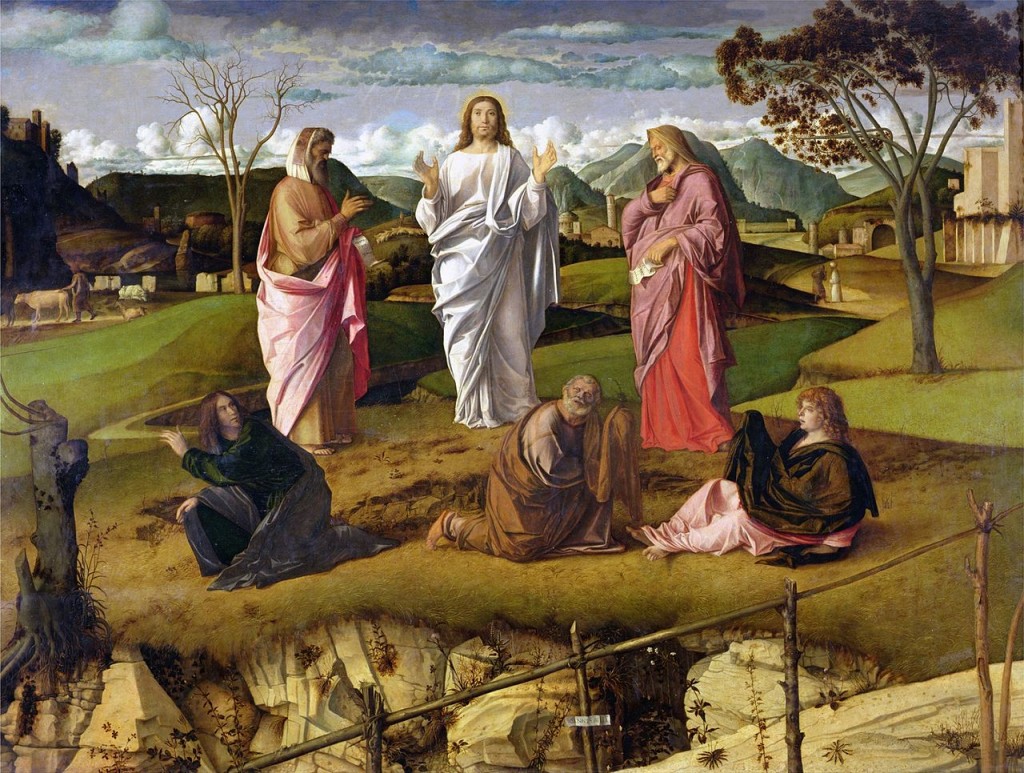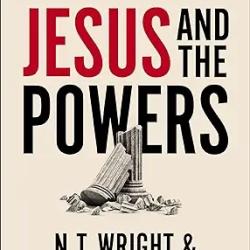The following is a sermon by my Doktor Vater, C.K. Barrett, a formidable Methodist preacher, in addition to all his scholarly work. I am in the process of producing several volumes of his sermons and the sermons of his father, Fred Barrett, a famous Methodist Evangelist and preacher in the 20th century. The volumes will be entitled Luminescence. The thing that characterizes these sermons is in depth interaction with both the Biblical text and the Wesleyan tradition of theology and hymnody. The painting above is the one CKB refers to in the sermon below. CKB preached from 1934 until 2010 or so, which is to say in nine different decades. See what you think. BW3
“THE TRANSFIGURATION”—MARK 9.7
[Preached eighteen times from 8/5/45 at Bondgate to 8/8/99 at Bitty Row]
It is some time since I gave some scope to my interest in the Church calendar. I am doing so again this morning. Tomorrow is the Feast of the Transfiguration, and today we shall think about that event. I think it is a positively good subject for a Sunday morning when we are celebrating the Holy Communion together.
In recent years, a good deal has been written about the Transfiguration, and I could very easily fill up the time this morning by giving you a resume of the learned stuff I have read on the subject. I do not propose to do so. I want to ask what is always the most practical and perhaps also the most scientific question that one can ask about a passage in the Gospels. The persons of the old first century Church who told these stories before ever they were written down and who read them while the ink was still fresh—what did they find in the stories? They were not fools and they were not different from us. They would not have gone on telling the stories if they had found nothing in them. What then did they find in this one?
I think I have mentioned before to you a picture of the Transfiguration which I very much like. It is by Giovanni Bellini and you can find it at Naples—or you could before the war. Bellini was a Venetian painter and the Mount of Transfiguration is just one of the little hills behind Venice. In the foreground of course are Christ, Moses and Elijah, with the apostles dazed upon the ground. But winding around the shoulder of the hill comes a team of oxen driven by a Venetian peasant. The Transfiguration is going on in the heart of human affairs.
Bellini’s instinct is exactly right. And now we are to take the place of the peasant, not driving oxen but perhaps driving a car at the foot of the Holy Mountain. For it is here, and we are bidden to come near. What then does the story mean to simple folk whether in the first century or the twentieth? It speaks first of—
THE INCOMPARABLE GLORY OF CHRIST
The writers of the New Testament are always trying to express that which continually escapes them— the inexpressible majesty and goodness of the Son of God who redeemed them and made all things new. They seem never to have been satisfied with their own efforts, but this little passage must have gone a long way. Look at the details and see how much is said.
Moses and Elijah—strange figures, but our simple minded reader, and our simple minded narrator, know what they meant. They represented the Law and the Prophets. And here were the Law and the Prophets paying their homage, bearing their witness to Christ. Christ, they would say—is the Law. The Law is the embodiment of what God wants. Moses had got part of it down in words, syllables, and letters. How dull, how inadequate, how impotent, how unlovely. But here is the same thing in life. I can remember Pastoral Theology lectures when I was at college. I won’t say I learned nothing from them, I remember far more than what our Methodist Minister says he remembered, namely the maxim—‘in stormy weather, the service at the graveside should not be unduly prolonged.’ But I never bothered about them as much as some men did. You see I had even then been living more than twenty years in the home of a living ideal of Pastoral Theology, and the man was better than the rules. So here. Not that a written law is useless; there are plenty of people in the modern world who could profit from a study of such simple rules as , ‘thou shalt not steal, thou shalt not commit adultery’. But to see the Man, the God, how much more than means!
Christ was what the prophets were speaking. They were speaking God’s Word, he is God’s Word. The contrast is the same and the same sort of illustration will serve. My wife and I saw a photograph of our daughter about a fortnight before she was born, an X ray photograph of course. Now I don’t deny that film, it was very interesting to us, and extremely useful to the doctor. But now there is, not a film but a real solid baby. And there is a good deal of difference! I hope my analogy is clear. I don’t decry the prophets word, I dare not for it was not there word but God’s. But now there is the Word, God’s speech, God’s communication caught in flesh and blood. This is God himself, declaring himself to us, not in words but in life.
So much for Moses and Elijah, look at another feature— the cloud. Yes, very grand and impressive we say. But it is far more than that, for you must remember that even our simple-minded reader of the first century knew his Old Testament better than we do, most of us. A cloud; when Israel came out of Egypt God went before them in a pillar of cloud. When they had completed the tabernacle there rested upon it a cloud, which signified the presence of God. When Ezekiel saw his strange and complicated vision of God, he saw a great cloud with fire flashing continually and a brightness round about it. ‘Clouds and darkness,’ said the Psalm ‘are round about him.’ The cloud is not merely a striking and impressive phenomenon. It means God—no less. All this that is taking place is not the culmination of a chain of human endeavors, as if Christ were a greater Moses, the last and noblest of the prophets. It is the coming of God himself, heaven touches earth.
All this of course works to its climax in the voice that comes from heaven; ‘This is my Son, the Beloved’. The ratification of God himself is sealed upon the witness of the past and the present. Jesus stands among us as the representative of the most high God. He is that which is wholly different from us, wholly united to us in an unbreakable bond. But I have left out some of these words from heaven. Let us hear the remainder and give them a minute or two before we finish. ‘This is my Son, the Beloved’—
LISTEN TO HIM
They are of course precisely the words that are easiest and most natural to leave out. It is not unpleasant to contemplate the glory of Jesus. It may have a numinous thrill of terror to it, but that adds poignancy to the experience. It is not unpleasant to behold his glory. Peter thought that. ‘Let us make three tabernacles’ he says ‘it is such a good thing we are here.’ That was alright, that was the bright side of being a disciple. But there was another side. There was a time, and there were probably many times, when Jesus had been talking and people said ‘this saying is pretty steep, who can listen to it?’ or perhaps as it ought to be translated ‘who can listen to him?’
I am not surprised they said that, nor that at that point many of his disciples went home and travelled with him no longer. I have felt the same myself, and I suppose most of us are tainted, more or less, with the same brush. I hope I don’t insult you, probably you master the temptation, but I suspect you know what it is. We want the half pence of the Christian experience, but without the kicks. And the some of the words we have to hear from Jesus are like kicks— ‘let him deny himself… into all the world… whosoever loves his life…. Love your enemies’. Seeing the glory of Christ may mean the inspiration of quiet worship in this Church, hearing his word may mean rectifying a piece of business. Seeing his glory of Christ may mean the thrilling memory of the great days of Bondgate; hearing his word may mean knocking at doors and pleading with folk in Archer Street. I want to say only two things here before I finish. If you fail to hear and obey the word of Jesus, the vision of his glory will not last. If you do not, the things which he says, you will not see him in his Kingdom.
About forty years ago there was a very great preacher, I will not tell you his name, he was not a Methodist. He was learned, he was eloquent, he had piercing insight into human character, he could preach like a very angel. And then he quickly left the country. Soon afterwards, the sin he had committed was discovered. He was penitent I believe, but there was no more preaching. He had left the word of Jesus unheeded, and the fire and glow cooled and faded, the bright eye was dimmed, the eloquence was stilled. It is always so. If you neglect the word of Jesus, the fire of faith will burn hollow, it will tumble in, and nothing will be left but ashes, cold and black.
But second, if you rightly understand the glory of Jesus, you will find there also the authentic word of Jesus. Luke makes an addition to the story of the Transfiguration. He tells us what Jesus, Moses, and Elijah were talking about. They were talking about— his death. There at that moment of glory, they were talking about the green hill, the hill of the skull—Calvary. The whole thing is all of a piece.
In his book, In Search of England, H.V. Merton tells of a hill in Hampshire on which stands a gallows. He asked why it was there. The answer was that there was in a nearby town there was a Charity whose rule was that it should continue only as long as that gallows stood on the hill. While the gallows lasted, the charity endured. It is while there is a gallows, a cross, on the hill that charity endures. It is so for God, it is so for us. As long as there is a cross on the hilltop of our religious experience the charity will not die out of our hearts. That is the great value of this Holy Supper, and of course of all true preaching. The bread is broken, the wine is poured out, that you and I may be broken and spilt in the service of God.
—-














